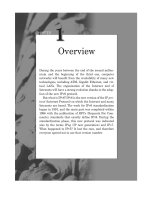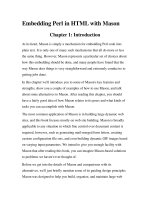Chapter 1 v7 01 accessible
Bạn đang xem bản rút gọn của tài liệu. Xem và tải ngay bản đầy đủ của tài liệu tại đây (2.77 MB, 100 trang )
Computer Networking: A Top Down
Approach
Seventh Edition
Chapter 1
Introduction
Slides in this presentation contain
hyperlinks. JAWS users should be
able to get a list of links by using
INSERT+F7
Copyright © 2017, 2013, 2010 Pearson Education, Inc. All Rights Reserved
Introduction (1 of 2)
Our Goal:
• get “feel” and terminology
• more depth, detail later in course
• approach:
– use Internet as example
Copyright © 2017, 2013, 2010 Pearson Education, Inc. All Rights Reserved
Introduction (2 of 2)
Overview:
• What’s the Internet?
• What’s a protocol?
• network edge; hosts, access net, physical media
• network core: packet/circuit switching, Internet structure
• performance: loss, delay, throughput
• security
• protocol layers, service models
ã history
Copyright â 2017, 2013, 2010 Pearson Education, Inc. All Rights Reserved
Learning Objectives (1 of 7)
1.1 what is the Internet?
1.2 network edge
– end systems, access networks, links
1.3 network core
– packet switching, circuit switching, network structure
1.4 delay, loss, throughput in networks
1.5 protocol layers, service models
1.6 networks under attack: security
1.7 history
Copyright © 2017, 2013, 2010 Pearson Education, Inc. All Rights Reserved
What’s the Internet: “Nuts and Bolts” View (1 of 2)
• billions of connected computing devices:
– hosts = end systems
– running network apps
• communication links
– fiber, copper, radio, satellite
– transmission rate: bandwidth
• packet switches: forward packets (chunks
of data)
– routers and switches
Copyright © 2017, 2013, 2010 Pearson Education, Inc. All Rights Reserved
What’s the Internet: “Nuts and Bolts” View (2 of 2)
Copyright © 2017, 2013, 2010 Pearson Education, Inc. All Rights Reserved
“Fun” Internet-Connected Devices
Web-enabled toaster +
weather forecaster
IP picture frame
/>
Slingbox: watch,
control cable TV remotely
Internet
refrigerator
Tweet-a-watt:
monitor energy use
sensorized,
bed
mattress
Internet phones
Copyright © 2017, 2013, 2010 Pearson Education, Inc. All Rights Reserved
What’s the Internet: “Nuts and Bolts” View
• Internet: “network of
networks”
– Interconnected ISPs
• protocols control sending,
receiving of messages
– e.g., TCP, IP, HTTP,
Skype, 802.11
• Internet standards
– RFC: Request for
comments
– IETF: Internet
Engineering Task Force
Copyright © 2017, 2013, 2010 Pearson Education, Inc. All Rights Reserved
What’s the Internet: A Service View
• infrastructure that provides
services to applications:
– Web, VoIP, email, games, ecommerce, social nets, …
• provides programming
interface to apps
– hooks that allow sending and
receiving app programs to
“connect” to Internet
– provides service options,
analogous to postal service
Copyright © 2017, 2013, 2010 Pearson Education, Inc. All Rights Reserved
What’s a Protocol? (1 of 2)
human protocols:
network protocols:
• “what’s the time?”
• machines rather than humans
• “I have a question”
• all communication activity in
Internet governed by protocols
• introductions
… specific messages sent
… specific actions taken
when messages received,
or other events
protocols define format, order
of messages sent and
received among network
entities, and actions taken on
message transmission, receipt
Copyright © 2017, 2013, 2010 Pearson Education, Inc. All Rights Reserved
What’s a Protocol? (2 of 2)
A human protocol and a computer network protocol:
Q: other human protocols?
Copyright © 2017, 2013, 2010 Pearson Education, Inc. All Rights Reserved
Learning Objectives (2 of 7)
1.1 what is the Internet?
1.2 network edge
– end systems, access networks, links
1.3 network core
– packet switching, circuit switching, network structure
1.4 delay, loss, throughput in networks
1.5 protocol layers, service models
1.6 networks under attack: security
1.7 history
Copyright © 2017, 2013, 2010 Pearson Education, Inc. All Rights Reserved
A Closer Look at Network Structure:
• network edge:
– hosts: clients and
servers
– servers often in data
centers
• access networks, physical
media: wired, wireless
communication links
ã network core:
interconnected routers
network of networks
Copyright â 2017, 2013, 2010 Pearson Education, Inc. All Rights Reserved
Access Networks and Physical Media
Q: How to connect end systems to
edge router?
• residential access nets
• institutional access networks
(school, company)
• mobile access networks
keep in mind:
• bandwidth (bits per second) of
access network?
• shared or dedicated?
Copyright © 2017, 2013, 2010 Pearson Education, Inc. All Rights Reserved
Access Network: Digital Subscriber Line
(DSL) (1 of 2)
Copyright © 2017, 2013, 2010 Pearson Education, Inc. All Rights Reserved
Access Network: Digital Subscriber Line
(DSL) (2 of 2)
• use existing telephone line to central office DSLAM
– data over DSL phone line goes to Internet
– voice over DSL phone line goes to telephone net
• < 2.5 Mbps upstream transmission rate (typically < 1 Mbp
s)
• < 24 Mbps downstream transmission rate (typically < 10
Mbps)
Copyright © 2017, 2013, 2010 Pearson Education, Inc. All Rights Reserved
Access Network: Cable Network (1 of 3)
frequency division multiplexing: different channels transmitted
in different frequency bands
Copyright © 2017, 2013, 2010 Pearson Education, Inc. All Rights Reserved
Access Network: Cable Network (2 of 3)
Copyright © 2017, 2013, 2010 Pearson Education, Inc. All Rights Reserved
Access Network: Cable Network (3 of 3)
• HFC: hybrid fiber coax
– asymmetric: up to 30Mbps downstream transmission
rate, 2 Mbps upstream transmission rate
• network of cable, fiber attaches homes to ISP router
– homes share access network to cable headend
– unlike DSL, which has dedicated access to central
office
Copyright © 2017, 2013, 2010 Pearson Education, Inc. All Rights Reserved
Access Network: Home Network
Copyright © 2017, 2013, 2010 Pearson Education, Inc. All Rights Reserved









